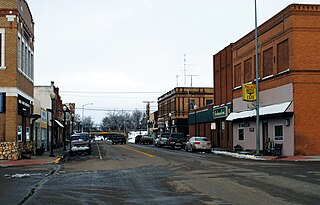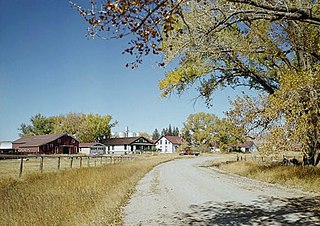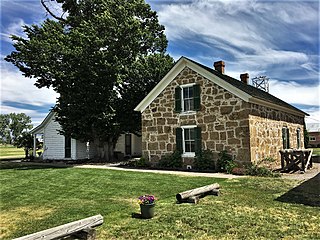
Wibaux County is a county in the U.S. state of Montana. As of the 2020 census, the population was 937, making it the fourth-least populous county in Montana. Its county seat is Wibaux.

Wibaux is a town in and the county seat of Wibaux County, Montana, United States. It is the only incorporated town in Wibaux County. The population was 589 at the 2020 census.

Lyndon B. Johnson National Historical Park is a United States National Historical Park in central Texas about 50 miles (80 km) west of Austin in the Texas Hill Country. The park protects the birthplace, home, ranch, and grave of Lyndon B. Johnson, 36th president of the United States. During Johnson's administration, the LBJ Ranch was known as the Texas White House because the President spent approximately 20% of his time in office there.

Buffalo Bill Ranch State Historical Park, known as Scout's Rest Ranch, is a living history state park located west of North Platte, Nebraska. The ranch was established in 1878 with an initial purchase of 160 acres south of the Union Pacific tracks by William Cody. The 4,000 acre ranch was sold in 1911 and has been under the management of the Nebraska Game and Parks Commission since 1964. The 25 acre historic state park, added to the National Register of Historic Places in 1978 and designated a National Historic Landmark in 2021, is open weekdays from April to October. The house and outbuildings can be toured, including a museum documenting Cody's life from a Pony Express rider to his Wild West shows.

Rancho Petaluma Adobe is a historic ranch house in Sonoma County, California. It was built from adobe bricks in 1836 by order of Mariano Guadalupe Vallejo. It was the largest privately owned adobe structure built in California and is the largest example of the Monterey Colonial style of architecture in the United States. A section of the former ranch has been preserved by the Petaluma Adobe State Historic Park and it is both a California Historic Landmark and a National Historic Landmark. The Rancho Petaluma Adobe State Historic Park is located on Adobe Road on the east side of the present-day town of Petaluma, California.

Pierre Wibaux was a French cattle owner and ranchman in Montana and North Dakota at the turn of the 20th century. He immigrated from his native France to seek business opportunities in America and was among the most successful in the second wave of "Frontier Cowboys".

The Swan Land and Cattle Company Headquarters are a historic ranch headquarters complex on Wyoming Highway 313 in Chugwater, Wyoming. Organized in 1883 in Scotland, the Swan Company was one of the largest ranching operations in the nation in the late 19th and early 20th centuries, managing more than one million acres of land. Now a much smaller operation, its former headquarters complex was declared a National Historic Landmark in 1964.

Rooney Ranch is an historic ranch near Morrison, unincorporated Jefferson County, Colorado. Alexander Rooney came west in 1859 seeking an opportunity. He did a variety of work to earn his keep from stone masonry, cartage of lumber and other supplies to the mining camps around Denver and South Park, to a dairy farm. He found the high altitude uncomfortable, so he sought out winter pasture at lower elevations for his cattle. In the fall of 1861 he found what he was looking for along the eastern edge of the hogback, between the mountains and the plains. He brought his wife, Emeline, and his family west from Anamosa, Iowa.
The T E Ranch Headquarters, near Cody, Wyoming, is a log ranch house that belonged to buffalo hunter and entertainer Buffalo Bill Cody (1846–1917). The house may have originally been built by homesteader Bob Burns prior to 1895, when Cody acquired the ranch. Cody expanded the ranch to about eight thousand acres (32 km2), using the T E brand for his thousand head of cattle.

The Charles Boyd Homestead is a group of three buildings that make up a pioneer ranch complex. It is located in Deschutes County north of Bend, Oregon, United States. The ranch buildings were constructed by Charles Boyd between 1905 and 1909. Today, the three surviving structures are the only ranch buildings that date back to the earliest period of settlement in the Bend area. The Boyd Homestead is listed as a historic district on the National Register of Historic Places.

The Dangberg Home Ranch Historic Park is a Douglas County, Nevada, USA, park, preserving one of the state's first ranches.

The P Ranch is a historic ranch in Harney County in southeastern Oregon, United States. The remaining ranch structures are located on the west bank of the Donner und Blitzen River in the Malheur National Wildlife Refuge. The ranch was built by Peter French, a well known 19th-century cattle baron. The P Ranch became headquarters for the French-Glenn Livestock Company, which eventually covered over 140,000 acres (570 km2). After French was murdered in 1897, the French-Glenn Livestock Company slowly sold off the P Ranch property. In 1935, the United States Government purchased the remaining P Ranch property to add to an adjacent wildlife refuge. The Civilian Conservation Corps demolished most of the original ranch buildings in the 1930s, and a fire destroyed the main ranch house in 1947. The few remaining P Ranch structures are now listed on the National Register of Historic Places.

The Circle Ranch, also known as the R.L. Miller Ranch has been continuously operated as a working cattle ranch for more than 100 years. Located in Sublette County, Wyoming, it was first occupied as a homestead by Otto Liefer between 1878 and 1880. Liefer sold his claim to James Mickelson in 1895, who developed the ranch into one of the largest ranching operations in the area. The ranch has remained in the Mickelson family ever since.

The Sod House Ranch is a historic ranch in Harney County in southeastern Oregon, United States. The remaining ranch structures are located south of Malheur Lake in the Malheur National Wildlife Refuge. The ranch was built by Peter French, a well known 19th-century cattle baron. The Sod House Ranch became the headquarters for the northern operating division of the French-Glenn Livestock Company, which eventually covered over 140,000 acres (570 km2). After French was murdered in 1897, the French-Glenn Livestock Company slowly sold off its ranch property. In 1935, the United States Government purchased the Sod House Ranch property to add to an adjacent wildlife refuge. The eight remaining Sod House Ranch buildings are now listed on the National Register of Historic Places.

The W.C. Child Ranch also known as the Kleffner Ranch and the Child-Kleffner Ranch is a national historic site located on state highway 518, south of East Helena, Montana, United States. It was added to the National Register of Historic Places on November 23, 1977.

The Wibaux Commercial Historic District is a site on the National Register of Historic Places located in Wibaux, Montana. It was added to the Register on December 28, 1989. It then included 12 contributing buildings.
The Thexton Ranch, also known as Thextondale, was established by George Thexton in 1872 on the Madison River about 7 miles (11 km) south of Ennis, Montana. The ranch is a significant example of an operating Montana ranch, and has been listed on the National Register of Historic Places for its prominence in local history and its character as a ranching operation.
NAN Ranch, also known as Y Bar NAN Ranch, is a ranch in Faywood, New Mexico, that was added to the National Register of Historic Places in 1988. The property was developed as a ranch beginning in the late-1860s by John Brockman, who grew corn, alfalfa, and several types of fruit and bred cattle. Cattleman John T. McElroy purchased the ranch in 1927 and hired Trost & Trost to renovate and expand the ranch compound to become the NAN Ranch headquarters. The project included a new house, extensive landscaping, swimming pool, a slaughterhouse, powerhouse, and other residential and ranch buildings. It is historically significant due to its architecture and its role as a major 19th century ranch.

The San Rafael Ranch, formerly known as the Greene Ranch, is a historic cattle ranch located in the San Rafael Valley about a mile and a half north of Lochiel, Arizona, near the international border with Sonora, Mexico.

Eagar Townsite Historic District is a section of the town of Eagar, Arizona which has been designated a National Historic Place. Sitting on roughly 54 acres, the site contains 37 structures, 21 of which have historical significance. The period of significance is from 1886, the year the townsite was founded, through 1942, which represents the significant period of development of the town. The site was added to the Register on July 23, 1993.



















